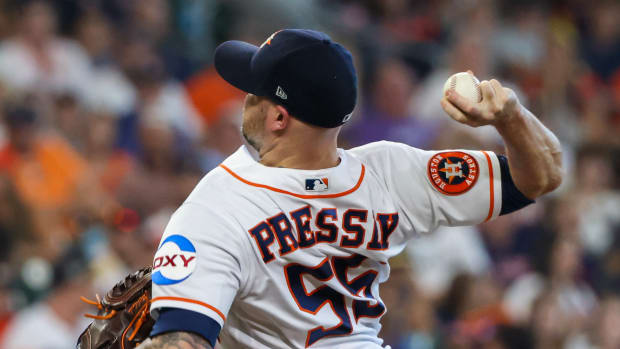
Semien's Windfall Resets Expectations Across the Board
With days to go until the collective bargaining agreement expires, the first domino has fallen on the crowded, talented shortstop market. But it’s not Carlos Correa or Corey Seager: It’s Marcus Semien, who has reportedly signed a seven-year, $175 million contract with the Texas Rangers. It’s a blockbuster deal for a club that hopes to start contending soon. It’s also a higher-than-expected number for Semien—which might hint at what the other top shortstops on the market will be getting. Here’s the breakdown of how it matters around the game:
What This Means for Semien
The infielder is a notable talent who was all but guaranteed to receive a significant contract. But the figures that came out on Sunday exceeded what had been even the most optimistic estimates for Semien.
FanGraphs had projected that he would receive four years and $120 million. The New York Post had five years and $140 million; The Athletic had five years and $148 million, and MLB Trade Rumors had six years and $138 million. Note that none of those included a seventh year or touched $150 million—let alone $175 million.
So how did Semien end up landing a deal like this? A great place to start is the fact that he leads all position players in Baseball-Reference WAR since the start of 2019. (His 15.9 WAR exceeds Mookie Betts’ 15.0 and Juan Soto’s 14.5.) He’s the only player in either league who has been an MVP finalist twice in the last three seasons. He offers both power and speed, as the only player in the last three seasons to hit 85 or more home runs with 20 or more stolen bases, and he’s also notably durable: Semien has made just one trip to the IL since debuting in the majors in 2013. (He played all 162 regular-season games in both 2019 and 2021.) While he’s historically been a shortstop, he showed this past year just how capably he can handle second base, where he won his first Gold Glove. The takeaway here is as good as all of the above would suggest: Semien is a quality all-around player who’s been one of the very best in the game over the last few years.
Yet there are a few points that slip him behind a name like Correa or Seager. The clearest is his age: At 31, he’s the oldest of the premium shortstops available this winter, all of whom are under 30. That seemed to make him more likely to sign a four- or five-year deal than anything longer and, therefore, made him a better fit for a team that was in win-now mode. (This obviously didn’t happen! But more on the Rangers’ motivation below.) The other lingering question was attached to his history. Yes, Semien has looked like a star since 2019. But he had looked simply like a solid everyday player in every year before that. That’s not a bad thing to be, of course, and Semien was remarkably consistent at it: He posted an OPS+ between 95 and 99 in each of his first four full major-league seasons. But it does mean that his long-term track record is not as established as some other members of this class—even if you’re inclined to believe that he’ll stick with his recent levels of production, this is still a factor to note, particularly with his age.
Which all comes down to a bottom line something like this: Semien has shown that he can play at the highest level, and he’s found a team that was willing to bet big on him doing the same going forward, for longer than anyone had guessed.
What This Means for the Rangers
First, the obvious: This is very, very good for Texas! Semien is an excellent player, as detailed above, and this makes the Rangers considerably better than they were yesterday. It addresses a key area of need—shortstop was an obvious hole for them to fill—and it pushes them closer to becoming a winning team.
But there are still valid questions about the fit here. Semien made plenty of sense for a team that was already playoff-ready: Texas isn’t that. (Unless there are some additional big moves coming—which it does sound like there might be.) The Rangers are five years removed from their last winning season, and while they’ve started to put the pieces together to pull out of their rebuild, they don’t look like a contender quite yet. That makes Semien a somewhat curious choice—but it doesn’t make him a bad one, and they’ve already started making complementary moves to make it a somewhat better fit.
Besides a shortstop, Texas needed starting pitching and some outfield help. The team started addressing both categories almost right away: The Rangers are reportedly now in agreement with former Rockies pitcher Jon Gray for four years and $56 million and also with outfielder Kole Calhoun. With Gray, they’re taking a gamble on unlocking the upside from a pitcher who has historically been an up-and-down mid-rotation arm. (Just freeing him from Coors Field should help.) With Calhoun, they’re getting some potentially useful depth. These moves don’t necessarily make a winning team—at least, not by themselves, and not right away. (Remember: The Rangers are not so much knocking on the door right now as they are still walking up the front steps in sight of the door.) But they help lay the foundation. And they would make even more sense when paired with an even bigger, splashier signing—like, say, another premium shortstop?
Yes, we know, you’re reading about how they just signed a huge deal for shortstop Marcus Semien. But Semien can play second—he’s probably a better long-term fit there than he is at short—and he’s reportedly interested in sticking at the keystone if he has to accommodate another shortstop. That would allow the Rangers to add someone like Trevor Story, which is the kind of deal that could help catapult them into contention sooner than these moves would alone. And they could probably use another outfielder, too, while they’re at it. Would that be a lot for one offseason? Of course. But given how much ground Texas has to cover just to get to .500—this team lost 102 games in 2021!—it makes far more sense to think of these moves as a beginning rather than an ending. To sign Semien and Gray is an indication that the Rangers would like to start winning sooner rather than later. It stands to reason that they should keep pursuing additional moves to make that happen.
What This Means for the Rest of the Shortstop Market
Correa, Seager and Story (and, to a far lesser extent, Javier Báez) were always going to get paid. But if Semien is able to pull down a seven-year deal like this? It might be worth revising your other shortstop contract predictions upwards.
More MLB Coverage
• Giants Get Band Back Together in Push to Replicate 2021 Magic
• Rays Finally Decide to Raise One of Their Own
• Mets Flex Their Financial Might on Black Friday
• The Astros Aren't Breaking Up Just Yet
• Rankings and Predictions for MLB's Top 50 Free Agents



































